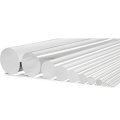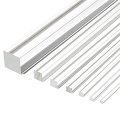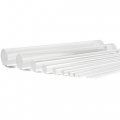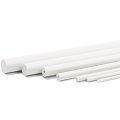Acrylic Glass Rods
Acrylic Rods Information
We are often asked, “What is the difference between acrylic glass and PLEXIGLAS®?” Well, you might be surprised to learn that there is basically no difference: PLEXIGLAS® is the name that was given to the material known as acrylic glass by its inventor, the company Röhm. That trade name eventually became part of common speech. In terms of quality, there is really no appreciable difference between the products offered by Röhm and those of other producers.
Acrylic glass rods are good light conductors. Lighting only the cut surface at one end, however, will not lead to light emitting from the other end. The cut surfaces only radiate very brightly when light is shined on, and absorbed at the outer surface. Polishing the cut surfaces will increase this effect to a great extent. If you, on the other hand, they are finished with a matte surface (e.g. with a 400 grit wet sandpaper) with the idea that the light should exit at those areas, an even stronger “point of light” will be produced.
Extruded acrylic glass rods can be cut without any difficulty with a household saw, a metal saw or a circular bench saw. Alternatively, you can request that the rods be cut to size by Modulor (see custom cutting service). The cut surfaces should nevertheless be sanded and polished so as to have a really clean look (see: SANDING and POLISHING AGENTS). Gluing work can be done with solvent or special acrylic adhesives.
Thermal bending is easy to do with the help of a heat gun. In doing so, the area that needs to be bent should be heated up to the deformation temperature (test this!) and simply bent to the desired shape.



